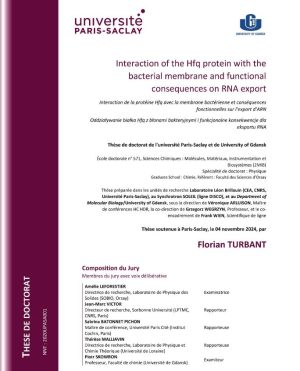Résumé :
Hfq est un régulateur bactérien pléïotrope intervenant dans plusieurs aspects du métabolisme de I’ ARN. La protéine régule notamment l’efficacité de la traduction et la dégradation des ARN chez les bactéries Gram(-). Elle facilite également l’appariement de petits ARN non codants (ARNnc) régulateurs avec un ARN messager (ARNm) cible, généralement autour du site de liaison au ribosome (RBS) de l’ARNm et/ou du codon d’initiation de la traduction. Cela permet une régulation au niveau post-transcriptionnel, généralement de manière négative. La modulation post-transcriptionnelle de l’expression des gènes peut ainsi affecter l’adaptation des bactéries à des environnements changeants, ce qui peut être d’une importance primordiale pour le contrôle de la division cellulaire, le « quorum sensing » ou la virulence des bactéries pathogènes.
Les résultats obtenus en amont de cette thèse ont démontré que la région C-terminale de Hfq forme une structure de type amyloïde qui interagit avec les membranes. La conséquence immédiate de cette interaction est une rupture de la membrane, mais l’effet de la membrane sur la structure amyloïde était inconnu.
Ce travail de thèse met en lumière, en utilisant différentes techniques innovantes de biophysique telles que le Dichroïsme Circulaire Orienté ou la Spectroscopie Infrarouge polarisée, le mode d’interaction de Hfq avec la paroi bactérienne. Ainsi j’ai contribué à démontrer que la protéine Hfq s’insère via sa partie C-terminale dans la membrane bactérienne dans des régions bien précises, riches en cardiolipine. J’ai également pu être montrer que Hfq pourrait jouer un rôle important dans la communication cellulaire, de par sa présence dans des vésicules de membranes externes (OMV) secrétées dans le milieu extracellulaire.
Dans cette thèse l’aspect thérapeutique a également été abordé avec l’identification du rôle de Hfq dans la résistance aux antibiotiques, mais également de par la caractérisation d’inhibiteurs efficaces disruptant la structure amyloïde de Hfq, ce qui affecte la survie des bactéries.
Grâce aux différents résultats contenus dans mes travaux, !’études de nouvelles approches antibactériennes, visant à déstabiliser la bactérie dans sa quête de résistance aux antibiotiques, sont proposées.
Mots clés: Hfq, Amyloïde, Membrane bactérienne, Adaptation au Stress, Biophysique.
Interaction of the Hfq protein with the bacterial membrane and functional consequence on RNA export
Abstract:
Hfq is a pleiotropic bacterial regulator involved in several aspects of RNA metabolism. In particular, the protein regulates translation efficiency and RNA degradation in Gram-negative bacteria. It also facilitates the pairing of small regulatory non-coding RNAs (sRNAs) with their target messenger RNA (mRNA), usually via biding around the ribosome binding site (RBS) of the mRNA and/or the initiation codon. This enables a regulation at the post-transcriptional level, usually in a negative way. Post-transcriptional modulation of gene expression can thus affect the adaptation of bacteria to changing environments, which may be of paramount importance for the control of cell division, quorum sensing or the for virulence of pathogenic species.
Results obtained prior this thesis demonstrated that the C-terminal region of Hfq forms an amyloid-like structure that interacts with membranes. The immediate consequence of this interaction is membrane rupture, but the effect of the membrane on the amyloid structure was unknown.
This thesis work highlights the characterization of the mechanism of interaction with the bacterial membrane via various innovative biophysical techniques (such as Oriented Circular Dichroism or Polarized Fourier Transform Infrared Spectroscopy). With these different methods, it was possible to prove that the C-terminal part of the Hfq protein was inserted into the bacterial membrane at very precise locations, rich in cardiolipin. It is also proposed that Hfq can play an important role in cellular communication thanks to its presence in external membrane vesicles (OMVs), secreted into the extracellular milieu. The therapeutic aspect was also addressed in this thesis, with the identification of the role of Hfq in antibiotic resistance, but also the characterization of effective inhibitors targeting the amyloid structure.
Thanks to the various results contained in this work, this thesis opens the door to the study of new antibacterial approaches, aiming at destabilizing bacteria in their quest for antibiotic resistance.
Keywords: Hfq, Amyloid, Bacterial Membrane, Adaptation to stress, Biophysic.


